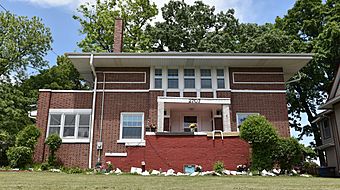Mahnke House facts for kids
Quick facts for kids |
|
|
Mahnke House
|
|
|
U.S. Historic district
Contributing property |
|
 |
|
| Location | 2707 High St. Des Moines, Iowa |
|---|---|
| Built | 1909 |
| Built by | Fred W. Weitz |
| Architectural style | Prairie School |
| Part of | Ingersoll Place Plat Historic District (ID00000931) |
| NRHP reference No. | 83003622 |
| Added to NRHP | October 13, 1983 |
The Mahnke House is a historic home located in Des Moines, Iowa, United States. It was built in 1909 by Fred W. Weitz, a well-known builder in Des Moines. This house is special because it shows off the Prairie School style of architecture.
About the Mahnke House
The Mahnke House is a beautiful example of early 20th-century design. Its exterior is made of brick laid in a pattern called Flemish bond. This means the bricks are arranged in a special way that looks very neat.
Building Style and Features
The house has a hip roof, which slopes down on all four sides. On the west side, there's a small, sunny room called a solarium. This room is perfect for enjoying the sun. There's also a porch at the back of the house.
At the front, you'll see a flat-roofed entrance area called a portico. It has a raised entrance and windows with square panes of glass. These details are typical of the Prairie School style, which focuses on horizontal lines and natural materials.
Who Lived Here?
The first owners of the house were George and Emma Mahnke. They lived there from 1909 until 1952. After that, they gave the house to the Des Moines Annual Conference of the Methodist Church. For many years, the house served as a home for the leaders of this church group.
Historic Recognition
The Mahnke House is important because of its history and architecture. In 1983, it was added to the National Register of Historic Places. This is a list of buildings, sites, and objects that are important to American history.
Later, in 2000, the house was also included in the Ingersoll Place Plat Historic District. This means it's part of a larger area recognized for its historical value. Being on these lists helps protect the house and its unique style for future generations.



